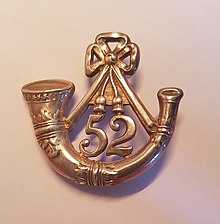52nd (Oxfordshire) Light Infantry Regiment
Sir John Clavering (1762–1778)
Cyrus Trapaud (1778–1801)
Sir John Moore (1801–1809)
The 52nd (Oxfordshire) Regiment of Foot was a light infantry regiment of the British Army throughout much of the 18th and 19th centuries. The regiment first saw active service during the American War of Independence, and were posted to India during the Anglo-Mysore Wars. During the Napoleonic Wars, the 52nd were part of the Light Division, and were present at most of the major battles of the Peninsula campaign, becoming one of the most celebrated regiments, described by Sir William Napier as "a regiment never surpassed in arms since arms were first borne by men". They had the largest British battalion at Waterloo, 1815, where they formed part of the final charge against Napoleon's Imperial Guard. They were also involved in various campaigns in India.
The regiment was raised as a line regiment in 1755 and numbered as the "54th Foot"; they were renumbered as the "52nd Regiment of Foot" in 1757. In 1781 the regional designation "52nd (Oxfordshire) Regiment of Foot" was given, and in 1803 the regiment was designated "Light Infantry". In 1881 the regiment was merged with the 43rd (Monmouthshire) Regiment of Foot to become the regiment later known as the Oxfordshire and Buckinghamshire Light Infantry.
Throughout the period of the 52nd's existence, the British Army comprised both infantry and cavalry line regiments, as well as the Household Divisions. The regiments of the line were numbered and, from 1781, were given territorial designations – "Oxfordshire" in the 52nd's case – which roughly represented the area from which troops were drawn. This was not rigid, and most English regiments had a significant proportion of Irish and Scots. Regiments comprised at least one battalion, often two – as the 52nd did intermittently – and occasionally more. Commanded by a lieutenant colonel, an infantry battalion was composed of ten companies, of which eight were "centre" companies, and two flank companies: one a grenadier and one (in regular line regiments) a specialist light company. Companies were commanded by captains, with lieutenants and ensigns (or subalterns) beneath him. Ideally, a battalion comprised 1000 men (excluding NCOs, musicians and officers); the 1st (or senior) battalion of a regiment would frequently draw fit recruits from the 2nd battalion to maintain its strength. If also sent on active service, the 2nd battalion would consequently be weaker. In periods of long service, battalions were generally operating under strength. Seriously under-strength battalions might be dissolved, or temporarily drafted into other regiments, as happened to the 52nd on several occasions.
...
Wikipedia

